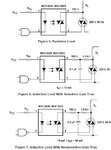ishtiaqshaheer
Junior Member level 3

Hi,I'm doing a dimmer which is connected to a relay to work as a switch to Turn ON/OFF.
Now the circuit which I implemented is this

where I'm using MOC3021 & BT138-800E(TRIAC)
and according to the MOC3021 Datasheet its written as for a sensitive gate use this Fig.2

Now my real doubt is where to connect Load ? whether to MT2 or MT1?
because both the figures shows different connections
and I think there will be no much difference if we change the terminals
and when I start dimming then the resistor connected to MT2 is getting burnt whether its 1k,10k,10k1/2W anything
and for 2-3 times the dimming worked after that the resistor starts burning?
is it because any other device like MOC3021 got burnt within this 2-3times or any other reasons?
please help me through this
Thanks in Advance
Now the circuit which I implemented is this

where I'm using MOC3021 & BT138-800E(TRIAC)
and according to the MOC3021 Datasheet its written as for a sensitive gate use this Fig.2

Now my real doubt is where to connect Load ? whether to MT2 or MT1?
because both the figures shows different connections
and I think there will be no much difference if we change the terminals
and when I start dimming then the resistor connected to MT2 is getting burnt whether its 1k,10k,10k1/2W anything
and for 2-3 times the dimming worked after that the resistor starts burning?
is it because any other device like MOC3021 got burnt within this 2-3times or any other reasons?
please help me through this
Thanks in Advance


